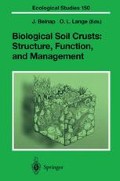Abstract
Rangefire is an important intermittent disturbance in many semiarid and arid lands. Limited interspace vegetation in hot deserts restricts the occurrence of fire, while shrub-steppe communities, with abundant bunch grasses between shrubs, have historically been prone to fire. The frequency of fire has increased notably with the invasion of exotic annual grasses, which are capable of carrying fire over thousands of acres in a single fire event. In particular, Bromus tectorum, or cheatgrass, has increased the frequency of rangefire in the shrub-steppes of North America (Billings 1994). Many native shrubs are not fire-resistant, and increased fire frequency could conceivably convert shrub-steppe to grasslands of annual and perennial grasses.
Access this chapter
Tax calculation will be finalised at checkout
Purchases are for personal use only
Preview
Unable to display preview. Download preview PDF.
References
Belnap J (1995) Surface disturbances: their role in accelerating desertification. Environ Monit Assess 37:39–57
Belnap J (1996) Soil surface disturbances in cold deserts: effects on nitrogenase activity in cyanobacterial-lichen soil crusts. Biol Fertil Soils 23:362–367
Belnap J, Sanford RL, Lungu L (1996) Biological soil crusts: ecological roles and response to fire in Miombo woodlands of Zimbabwe. Trans Zimbabwe Sci Assoc 70:14–20
Billings WD (1994) Ecological impacts of cheatgrass and resultant fire on ecosystems in the western Great Basin. In: Monson SB, Kitchen SG (eds) Ecology and management of annual rangelands. USDA Techn Report Ser, INT-GTR-313
Callison J, Brotherson JD, Bowns JE (1985) The effects of fire on the blackbrush (Coleogyne ramosissima) community of southwestern Utah. J Range Manage 38: 535–538
Chartres CJ, Mücher HJ (1989) The response of burned and unburned rangeland soil surfaces to simulated raindrop impact and water erosion. Earth Surface Processes Landforms 14:407–417
Eldridge DJ (1993) Cryptogam cover and soil surface condition: effects on hydrology on a semiarid woodland soil. Arid Soil Res Rehabil 7:203–217
Eldridge DJ, Bradstock RA (1994) The effect of time since fire on the cover and composition of cryptogamic soil crusts on Eucalyptus shrubland soil. Cunninghamia 3:521–527
Eldridge DJ, Tozer ME, Slangen S (1997) Soil hydrology is independent of microphytic crust cover: further evidence from a wooded semiarid Australian rangeland. Arid Soil Res Rehabil 11:113–126
Evans RD, Johansen JR (1999) Microbiotic crusts and ecosystem processes. Crit Rev Plant Sci 18:183–225
Greene RSB, Chartres CJ, Hodgkinson KC (1990) The effects of fire on the soil in a degraded semi-arid woodland. I. Cryptogam cover and physical and micromorphological properties. Aust J Soil Res 28:755–777
Jeffries DL, Klopatek JM, Link SO, Bolton H (1992) Acetylene reduction of cryptogamic crusts from a blackbrush community as related to resaturation and dehydration. Soil Biol Biochem 24:1101–1105
Johansen JR (1993) Cryptogamic crusts of semiarid and arid lands of North America. J Phycol 29:140–147
Johansen JR, Javakul A, Rushforth SR (1982) Effects of burning on the algal communities of a high desert soil near Wallsburg, Utah. J Range Manage 35:598–600
Johansen JR, St Clair LL, Webb BL, Nebeker GT (1984) Recovery patterns of cryptogamic soil crusts in desert rangelands following fire disturbance. Bryologist 87:238–243
Johansen JR, Ashley J, Rayburn WR (1993) Effects of rangefire on soil algal crusts in semiarid shrub-steppe of the lower Columbia Basin and their subsequent recovery. Great Basin Nat 53:73–88
Johansen JR, St Clair LL, Evans RD, Flechtner VR, Balczon J, Webb BL (1998) Resilience of biological soil species to military training pressures: natural and stimulated recovery following disturbance. Final Report for Contract DACA88-95-C-0015, submitted to the US Army Construction Engineering Res. Lab, Champaign, Illinois
Kaltenecker JH, Wicklow-Howard M, Pellant M (1999) Biological soil crusts: natural barriers to Bromus tectorum L. establishment in the northern Great Basin, USA. In: Eldridge D, Freudenberger D (eds) Proc VI Int Rangeland Congress, Aitkenvale, Queensland, Australia, pp 109–111
Kasper KA (1994) The effects of rangefire and trampling upon algal soil crusts of a greasewood community in the West Desert of Utah. MS Thesis, John Carroll University, University Heights, Ohio
Kinnell PIA, Chartres CJ, Watson CL (1990) The effect of fire on the soil in a degraded semi-arid woodland. II. Susceptibility of the soil to erosion by shallow rain-impacted flow. Aust J Soil Res 28:779–794
St Clair LL, Johansen JR, Webb BL (1986) Rapid stabilization of fire-disturbed sites using a soil crust slurry: inoculation studies. Reclam Reveg Res 4:261–269
West NE, Hassan MA (1985) Recovery of sagebrush-grass vegetation following wildfire. J Range Manage 38:131–134
Editor information
Editors and Affiliations
Rights and permissions
Copyright information
© 2001 Springer-Verlag Berlin Heidelberg
About this chapter
Cite this chapter
Johansen, J.R. (2001). Impacts of Fire on Biological Soil Crusts. In: Belnap, J., Lange, O.L. (eds) Biological Soil Crusts: Structure, Function, and Management. Ecological Studies, vol 150. Springer, Berlin, Heidelberg. https://doi.org/10.1007/978-3-642-56475-8_28
Download citation
DOI: https://doi.org/10.1007/978-3-642-56475-8_28
Publisher Name: Springer, Berlin, Heidelberg
Print ISBN: 978-3-540-43757-4
Online ISBN: 978-3-642-56475-8
eBook Packages: Springer Book Archive

